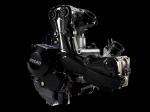Multistrada Testastretta 11 Degrees
By Kevin Ash - 01/07/2011
Ducati calls the engine fitted to the 2010 Multistrada the Testastretta 11 Degrees. What does that mean?
‘Testastretta‘ has been used before and means narrow head, which comes from the more compact cylinder head design that debuted on Ducati‘s liquid-cooled twins with the 998cc 996R in 2001. These had much more modern, narrow 25 degree angles between the inlet and exhaust valves (previously these were 40 degrees) resulting in more compact and efficient combustion chambers, with room for larger valves.

This remains the same in current Testastretta engines, instead the 11 refers to degrees of crankshaft rotation (no one‘s ever claimed Ducati‘s naming systems were straightforward...), the amount it turns in the period when all the valves are open at the same time. This is called overlap, and overlap angle is the degrees of crankshaft rotation that happens while they are, in this case 11.
You might expect the inlet valves to open and let in the fresh mixture only after the exhaust valves have closed and when the last of the exhausts gases have been expelled, but it was found long ago that efficiency was improved if you start to let the inlet gases in while the exhaust is still flowing out.

Overlap is important because of the gases‘ inertia. When you open the inlet valve the gas close to it is stationary, and it takes time to get moving. This process is enhanced if the exhaust gases are still rushing out as they draw in the inlet charge, but if the overlap is too long, the inlet gases will also start to flow out through the exhaust before the valves close. Ideally the valves will shut just as the inlet gases reach them, and while you can achieve this at a steady engine speed, you can‘t do it across the rev range.
At low revs, the gas has more time to fill the cylinder and a large amount of overlap will mean a lot of the inlet charge is lost. Rev the engine hard though and lots of overlap improves efficiency, as there‘s less time for the gas to fill the cylinders and little or none is lost.
Overlap is a major factor then in determining the nature of an engine: high performance engines have lots of overlap, but tend to run rougher, with worse emissions and efficiency at low revs than similar ones with less overlap.

The Multistrada is a good example. Its engine is directly developed from the Testastretta Evoluzione (the bigger capacity Testastretta developed from the 999) in the 1198, which makes 168bhp. This has an overlap angle of 41 degrees, good for high rev power and efficiency but less suited to slower running. The Multistrada would be expected to need better low rev manners and torque, hence the overlap angle has been reduced to 11 degrees. This is a major influence in the power reduction to 148bhp, and also means torque, smoothness and fuel efficiency at low revs have improved compared with the 1198.
Donate to the Kevin Ash Fund
Kevin's funeral was held on Thursday 28th February 2013 and was well attended by family, friends and colleagues.
The Telegraph has very kindly established The Telegraph Kevin Ash Fund to assist with the education of Kevin's three daughters.
If you'd like to make a donation then you can use the PayPal 'Donate' button below which will allow you to donate from your PayPal account, or via credit or debit card. A small percentage (about 3.4%) will be retained by PayPal for the service.
Kevin's family have been touched by the generosity and messages of support from people using the website and would like to express their gratitude to those who have contributed in any way.
The donations keep coming in, thank you so much, and the family especially like it when you leave a message.
Home | ![]() facebook.com/KevinAshFund
|
facebook.com/KevinAshFund
| ![]() twitter.com/KevinAshFund | © 2011
twitter.com/KevinAshFund | © 2011